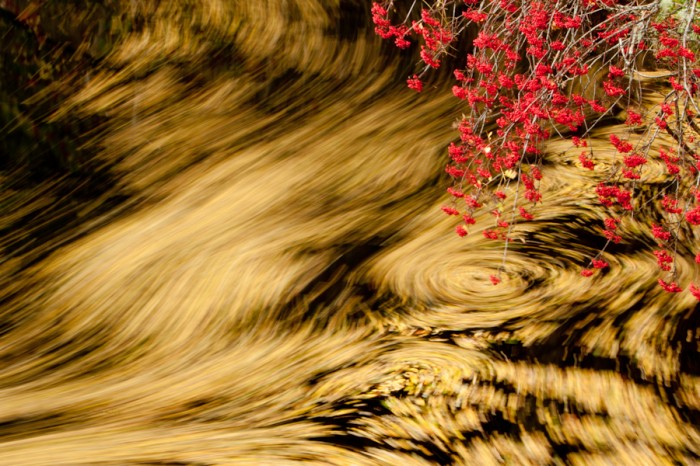Make time for time
Written by John MacphersonTime. Interesting stuff. Ask Prof Hawking. He knows a bit about time. He’s patiently thought about it….that takes….er…time, all that thinking.
So it’s just as well we’ve got it (time) otherwise he’d not have been able to come up with so many theories about it.
I love it when people try to catch me out and ask “Go on, which came first, the chicken or the egg?” And I confound them by saying, “Neither. Time came first. And it fills the space nicely in between the chicken and the egg, whichever way round they arrived.”
And they have to think about that, which obviously takes more time.
So I thought I’d try to photograph it. Time that is, not a chicken, nor an egg. And this is what resulted.
It’s a peaty-black highland river, in the autumn, just after a big wind. The wind, the previous evening, has stripped the leaves from the birch trees, some landing on the ground, others in the river. Freed from their branches they meander downstream, casually but unthinkingly interacting with their friends, a bit like sheep really (although sheep are actually quite bright despite the fact they like to follow each other).
The leaves respond to various factors, such as wind, but mostly they respond to the tug of the river. And below a fall as the water speeds up it moves and shifts its course around the riverbank or rocks, and creates swirls and eddies, all invisible, but their patterns given substance by the leaves. Their movement lets you see the eddies, the swirls and turns. But they are slow. Very slow.
And so, you need time. Quite a lot of it.
The tool of choice is a camera. What many folk don’t appreciate is that cameras are time banks. They can store time. They can capture fleeting memories of course, we all know that. But they can also capture things we cannot see, things we only glimpse a portion of, things we witness as one tiny inconsequential fragment.
Cameras can aggregate those fragments and make them visible for us. Pretty clever eh!
What does one need? First, a polarizing filter. It reduces the light entering the camera, by a significant factor, as a side effect of doing it’s job, which is to remove surface reflections from the water, to make the black water look really black (rather than shiny).
What else does one need? A dull day. So we have even less light. There’s a conundrum: how can a lack of light allow a better understanding of time?
Well the trick in all of this is to have the least amount of light possible that still allows you to see to be able to focus (and not fall in the river). Hence dull days, and dark filters, and a sturdy tripod. Which in combination lets you see time, as it strolls casually past.
And what results is a loooooooooooog exposure. On this particularly dingy day varying from 10 to 30 seconds….long enough for the sloooowwwly moving leaves to ‘write’ the path of their passage on your film or sensor.
The invisible made visible. How cool is that!
And the red berries behind? Well it’s a rowan, and they are auspicious trees, they keep witches away, but I think that’s another story……………for………er……..another time.
Just as well we have time then….don’t you think…..


Discussion (6 Comments)
Yep, another fine photograph. Water and space are quite alike, aren’t they?
Thanks Farhiz. Yes very alike.
A very fine illustration of time, the peaty black is a nice touch, but are there more? I feel like I see time or motion depicted by the leaves in a river eddy quite a bit. What I need is more time, and right now I have more of it than I’ve had in a long while. So maybe I should rephrase that – i need to organize and prioritize time, use it more wisely. Off I pop now…
Thanks Ed. Mind and take your time now, make every second count…….
Time will tell – It always does.
Time is the universe’s way of stopping everything all happening at once.